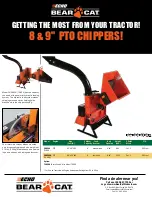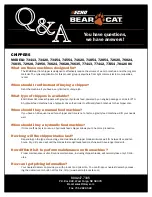
Transferring Refrigerant From Normal Opera-
tion into the Utility Vessel —
These steps describe
the method of moving refrigerant from the cooler/condenser/
compressor sections into the utility vessel. This is nor-
mally performed for service work on the cooler, condenser,
or the compressor components or for long-term machine
shutdown.
1. Isolate and push refrigerant into the utility vessel with
the pumpout compressor.
a. Valve positions: (Blank spaces indicate open valves).
VALVE
1
2
3
4
5
6
7
8
9
10
11
CONDITION
C
C
C
C
C
C
b. Turn off the machine water pumps and pumpout con-
denser water.
c. Turn on pumpout compressor to push liquid out of the
cooler/condenser/compressor section.
d. When all liquid has been pushed into the utility ves-
sel, close the cooler isolation valve 7.
e. Access the Control Test, Pumpdown function on the
LID display to turn on the machine water pumps and
view the machine pressures.
f. Turn off pumpout compressor.
2. Evacuate refrigerant gas from the cooler/condenser/
compressor vessel.
a. Valve positions: close valves 2 and 5, open valves 3
and 4.
VALVE
1
2
3
4
5
6
7
8
9
10
11
CONDITION
C
C
C
C
C
C
C
b. Turn on pumpout condenser water.
c. Run pumpout compressor until the suction reaches
15 in. Hg (50 kPa abs). Monitor pressures on the LID
and on the refrigerant gages.
d. Close valve 1.
e. Turn off pumpout compressor.
f. Close valves 3, 4, and 6. (All valves are now closed.)
g. Turn off pumpout condenser water.
h. Continue pumpdown function on the LID to turn off
the machine water pumps and to lock out the machine
compressor from operation.
Transferring Refrigerant from Normal Opera-
tion into the Cooler/Condenser/Compressor Sec-
tion —
These steps describe the method of moving refrig-
erant from the utility vessel into the cooler/condenser/
compressor section. This is normally performed for service
work on the utility vessel.
1. Isolate and push refrigerant into the cooler/condenser/
compressor section:
a. Valve positions:
VALVE
1
2
3
4
5
6
7
8
9
10
11
CONDITION
C
C
C
C
C
C
b. Turn off machine water pumps and pumpout con-
denser water.
c. Turn on pumpout compressor to push refrigerant out
of the utility vessel.
d. When all liquid is out of the utility vessel, close cooler
isolation valve 7.
e. Turn off pumpout compressor.
2. Evacuate refrigerant from the utility vessel.
a. Access the Control Test, pumpout function on the LID
display to turn on the machine water pumps and moni-
tor vessel pressures.
b. Valve positions: Close valves 3 and 4, open valves 2
and 5.
VALVE
1
2
3
4
5
6
7
8
9
10
11
CONDITION
C
C
C
C
C
C
C
c. Turn on pumpout condenser water.
d. Run the pumpout compressor until the suction reaches
15 in. Hg (50 kPa abs). Monitor pressures on the LID
and on refrigerant gages.
e. Close valve 6.
f. Turn off pumpout compressor.
g. Close valves 1, 2, and 5 (all valves are now closed).
h. Turn off pumpout condenser water.
i. Continue pumpdown function on the LID to turn off
machine water pumps and lock out the machine com-
pressor from operation.
Return
Refrigerant
to
Normal
Operating
Conditions
1. Be sure that the vessel that was opened has been evacu-
ated and dehydrated.
2. Access the Control Test, terminate lockout function to
view vessel pressures and to turn on machine water pumps.
3. Open valves 1, 3, and 6.
VALVE
1
2
3
4
5
6
7
8
9
10
11
CONDITION
C
C
C
C
C
C
C
C
4. Slowly open valve 5, gradually increasing pressure
in the evacuated vessel to 35 psig (141 kPa) for
HFC-134a. Feed refrigerant slowly to prevent freezeup.
5. Perform leak test at 35 psig (141 kPa).
6. Open valve 5 fully. Let vessel pressures equalize.
VALVE
1
2
3
4
5
6
7
8
9
10
11
CONDITION
C
C
C
C
C
C
C
7. Open valves 9 and 10.
8. Open valve 7 to equalize liquid refrigerant levels.
9. Close valves 1, 3, 5, and 6.
VALVE
1
2
3
4
5
6
7
8
9
10
11
CONDITION
C
C
C
C
C
C
C
C
10. Continue on with the terminate lockout function on the
LID to turn off water pumps and enable the compressor
for operation.
66
Summary of Contents for 17
Page 13: ...Fig 6 Open Drive 17 Series Lubrication Cycle 13 ...
Page 15: ...Fig 7 17EX Controls and Sensor Locations 15 ...
Page 16: ...Fig 7 17EX Controls and Sensor Locations cont 16 ...
Page 17: ...Fig 7 17EX Controls and Sensor Locations cont 17 ...
Page 19: ...Fig 8 19EX Controls and Sensor Locations cont 19 ...
Page 23: ...Fig 16 17 19EX LID Menu Structure 23 ...
Page 24: ...Fig 17 17 19EX Service Menu Structure 24 ...
















































